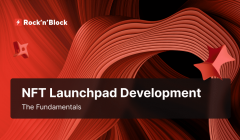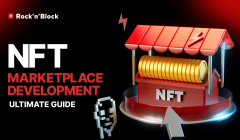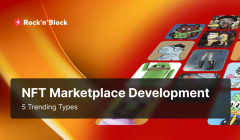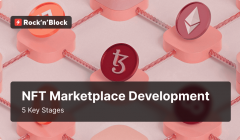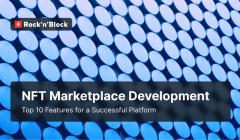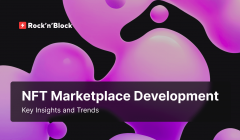NFT Marketplace Development Tools and Frameworks Overview
03 May 2024Welcome to an enlightening journey into the dynamic realm of NFT marketplace development. With increasing demand for NFTs, the development of robust and feature-rich NFT marketplaces is becoming critical. This article explores the world of NFT marketplace development, highlighting the necessary tools and frameworks that enable developers and entrepreneurs to create vibrant, safe, and adaptable platforms.
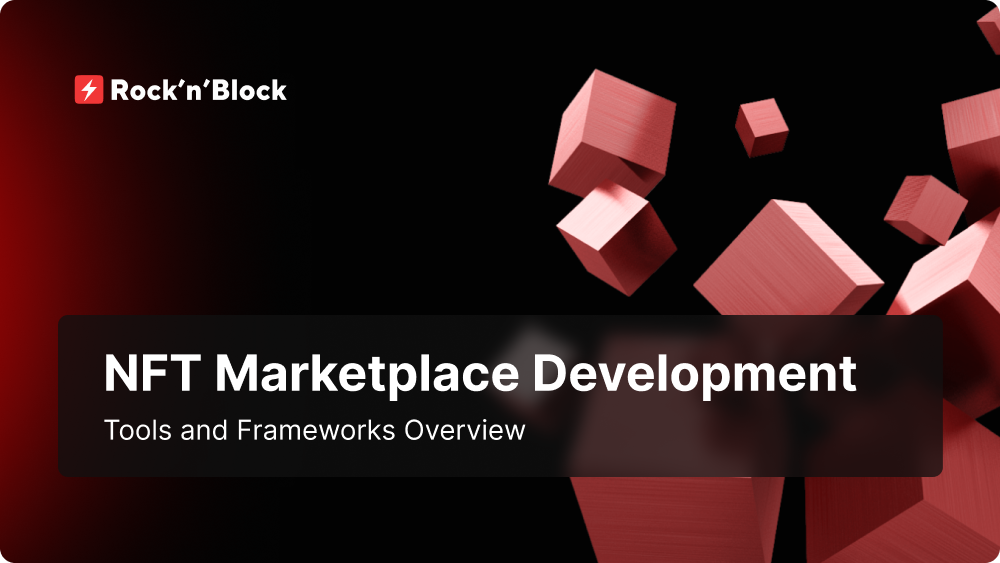
Table of Contents:
-
The Role of Tools and Frameworks in NFT Marketplace Development
-
Blockchain Platforms for NFTs
-
Smart Contract Development Frameworks and Tools
-
Decentralized Storage Solutions
-
Frontend Development Frameworks
-
Wallet Integration Tools
-
Security Tools
-
Scalability Solutions for NFT Marketplace Development
-
Interoperability Solutions for NFT Marketplace Development
-
Conclusion
The Role of Tools and Frameworks in NFT Marketplace Development
Behind the scenes of NFT marketplace development, various tools and development frameworks play an essential role. This article explains the vital importance of these technological components in shaping the architecture, security, and overall functionality of NFT marketplaces. For developers seeking to navigate the complex process of NFT platforms development, it is crucial to comprehend the value of these tools.
Blockchain Platforms for NFTs
The rise of Non-Fungible Tokens is closely connected to the underlying blockchain technology. This part delves into the crucial role played by several blockchain platforms in the NFT world. It highlights Ethereum as the trailblazing force and examines alternative platforms like Binance Smart Chain, Solana, and Flow.
Ethereum: The Pioneering Blockchain for NFTs
Ethereum is the foundation of the NFT revolution. Widely recognised for its intelligent contract capabilities, Ethereum has made NFT creation and trading possible through standard protocols such as ERC-721 and ERC-1155. Decentralized and open structure of Ethereum has significantly contributed to the broad acceptance of NFTs in various sectors, ranging from the arts and music to gaming and virtual property.
Nonetheless, Ethereum has faced several hurdles to its success. The network has encountered scalability challenges resulting in high gas fees and decelerated transaction confirmation time of intense demand. Both developers and users have been looking for solutions to these limitations, leading to the exploration of alternative blockchain platforms.
Alternatives and Considerations (Binance Smart Chain, Solana, Flow)
1. BNB Smart Chain (BSC): Binance Smart Chain quickly became a favored alternative to Ethereum. Being recognised for its lower transaction costs and faster transaction confirmation times, BSC attracted a significant user audience, specifically those searching for a more economical way for NFT trades.
2. Solana: Solana, with its high throughput and low transaction costs, has become popular as a scalable blockchain for NFT marketplace development. Its focus on performance and efficiency has helped to overcome some scalability challenges encountered on Ethereum. Developers are drawn to Solana due to its ability to handle a large number of transactions per second, providing a smooth experience for NFT creators, collectors and traders.
3. Flow: Flow introduced a unique approach to NFT projects development by providing a developer-friendly environment and scalability. Designed by the team that created CryptoKitties, Flow aimed to tackle the difficulties Ethereum encountered, especially in handling multi-currency applications.
When choosing blockchain platforms for NFT marketplace development shall weigh factors such as security, decentralization, scalability, and community support. Each platform brings its own strengths and considerations, making the choice dependent on the specific requirements and use case for NFT marketplace development.
Smart Contract Development Frameworks and Tools
In the realm of Non-Fungible Tokens (NFTs), smart contracts are vital for creation, management, and exchange of unique digital assets. In this section we will explore smart contract development frameworks and tools, with particular focus on Truffle and Hardhat, two key instruments, alongside an analysis of other frameworks.
Streamlining Smart Contract Development with Truffle
Truffle is a comprehensive development tool intended to streamline and improve the process of smart contract development on the Ethereum blockchain. Truffle offers a bundle of instruments that provide developers with a development environment, testing framework, and asset library. Its built-in support for common Ethereum standards, such as ERC-721, makes it an ideal option for NFT marketplace developers.
Using Hardhat for Ethereum Development
Hardhat is a modern alternative to Truffle that serves developers seeking greater flexibility and adaptability during the process of smart contract development. To address the evolving requirements of the Ethereum development community, Hardhat focuses on modularity and scalability, enabling developers to personalize their development environment to match project needs.
Other Frameworks for Simplified Smart Contract Deployment
Beyond Truffle and Hardhat, various other frameworks contribute to simplify deployment of smart contracts in the NFT space. Some notable mentions include:
1. Embark: Providing a straightforward and efficient development workflow, Embark focuses on ease of use and speedy deployment. It facilitates several blockchain platforms, what makes it adaptable for developers involved in cross-chain NFT projects.
2. Brownie: Brownie enhances developer efficiency through a Python-based development environment. It provides an integrated testing framework, network management tools, and supports Ethereum and Ethereum Virtual Machine (EVM) compatible chains.
3. Waffle: Tailored for TypeScript programmers, Waffle simplifies smart contracts testing on Ethereum. It seamlessly integrates with widely used testing libraries, offering a convenient platform for developers to guarantee the dependability of their NFT smart contracts.
In conclusion, selecting the right smart contract development framework is a critical choice for NFT marketplace developers. Whether choosing the resilience of Truffle, the adaptability of Hardhat, or exploring alternative frameworks, developers have a range of tools accessible to simplify the creation and deployment of smart contracts, thereby promoting further advancements within the NFT sphere.
Check out some useful resources we have prepared for you:
Decentralized Storage Solutions
In the world of NFT marketplace development, the importance of decentralized and secure storage solutions cannot be overstated. This section explores the roles of two significant players, IPFS and Arweave, in empowering decentralized and immutable file storage solutions. We’ll also share some insights of the factors to consider when selecting the optimal storage solution that caters to the unique requirements of your NFT marketplace development needs.
IPFS
The InterPlanetary File System (IPFS) is a groundbreaking technology that has revolutionized file storage. When it comes to NFTs, IPFS provides a decentralized method of storing metadata and media files for digital assets.
IPFS operates as a peer-to-peer hypermedia protocol, distributing files across a network of nodes, removing the usage of centralized servers. This model guarantees that NFT data stays immutable, as files are identified by their unique hash. Additionally, IPFS advances the security of NFT data and quickens data retrieval times, thereby contributing to a more flexible infrastructure.
Arweave
Arweave presents a pioneering concept in the realm of decentralized file storage, providing a permanent and tamper-proof solution, known as the "permaweb." With Arweave's architecture, data is stored indefinitely, ensuring that it remains accessible over time. The permanence of Arweave's design perfectly aligns with the long-term nature of NFTs, offering creators and collectors the assurance that their digital assets will sustain indefinitely.
Arweave achieves permanence via a unique consensus mechanism that utilizes a blockchain-like structure referred to as "blockweave". This structure serves to anchor data and makes it censorship or removal-resistant. Arweave's immutability and enduring nature make it an attractive choice for NFT marketplace developers seeking a strong and lasting storage solution.
Choosing the Right Storage Solution for NFT Marketplace Development
Selecting the right storage solution for an NFT marketplace development involves careful consideration of various factors:
1. Security: Assess the security features of the storage solution to ensure the protection of sensitive NFT data from unauthorized access.
2. Decentralization: Evaluate the level of decentralization offered by the storage solution, as a decentralized model enhances resilience and mitigates the risk of a single point of failure.
3. Cost: Consider the cost of storage, especially for large-scale NFT marketplaces. Some solutions may offer cost-effective storage options without compromising on performance.
4. Scalability: Ensure that the chosen storage solution can scale to accommodate the growing volume of NFTs and associated data as the marketplace expands.
5. Community Support: Opt for storage solutions that have strong community support and developer ecosystems, as this contributes to ongoing improvements and innovation.
In summary, decentralized storage solutions such as IPFS and Arweave play a critical role in the secure and resilient storage of NFT data. When selecting a storage solution for your NFT marketplace development, careful consideration of security, decentralization, cost, scalability and community support will pave the way for a robust and future-proof infrastructure.
Frontend Development Frameworks
Creating a seamless and engaging user interface (UI) is paramount to any NFT project development. In this section we will explore two popular UI frameworks - React.js and Vue.js - and dive into their role in front-end development. We’ll also cover Web3.js integration for blockchain interaction, and the balance of aesthetics and functionality in the UI of an NFT marketplace.
Popular Choices for Front-End Development
1. React.js: Developed by Facebook, React.js is a robust and widely used library for building user interfaces. Its component-based architecture facilitates modular development, making it an ideal choice for NFT marketplaces where modularity and reusability are critical. React's virtual DOM ensures efficient rendering, contributing to a smoother user experience.
2. Vue.js: Known for its simplicity and ease of integration, Vue.js has gained popularity in the front-end development landscape. Vue's progressive framework allows developers to adopt its features step-by-step, making it accessible to both novice and experienced developers. It makes Vue.js an attractive option for creating responsive and dynamic NFT marketplace interfaces.
3. Ethers.js: Ethers.js is a compact and versatile library for Ethereum Blockchain interaction, originally crafted for ethers.io. Its features include secure private key management, support for various wallet formats, connection to Ethereum nodes through multiple channels, and extensive documentation. With a small footprint, TypeScript compatibility, and an MIT License, Ethers.js is a preferred solution for diverse Ethereum development tasks.
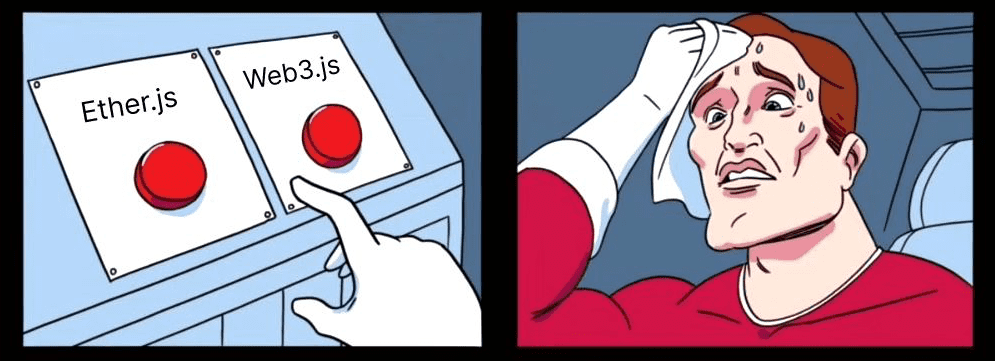
Integrating Web3.js for Blockchain Interaction
To overcome the gap between traditional web development and web3, the integration of Web3.js is essential. Web3.js is a JavaScript library that simplifies communication with Ethereum and other blockchain networks. In the context of NFT marketplaces development, Web3.js enables smooth interactions with smart contracts, allowing users to connect their wallets, view NFT collections, and initiate transactions directly from the interface.
The integration of Web3.js brings decentralized features to the forefront, empowering users to manage their NFT assets securely without relying on centralized intermediaries. This ensures that the NFT marketplace aligns with the principles of decentralization, providing users with true ownership and control over their digital assets.
Balancing Aesthetics and Functionality in NFT Marketplace UI
Achieving the balance between aesthetics, functionality and seamless user experience is a key consideration in UI development for an NFT marketplace.
1. Aesthetics
Visual Appeal: A visually appealing user interface increases user engagement. Incorporating intuitive design elements and attractive visuals contributes to a memorable and enjoyable user experience.
NFT Display: Prioritizing NFTs visibility in a clear way allows users to appreciate the uniqueness and details of each digital asset.
2. Functionality
User-Friendly UX: Ensure easy navigation for seamless exploration and interaction within the marketplace. Users should be able to browse collections, view details, and initiate transactions with ease.
Responsive Design: Ensure the UI gracefully adapts to a variety of different screens and orientations by implementing responsive design principles to meet the needs of users on different devices.
Overall, React.js, Vue.js and Ethers.js are the leading front-end tools for NFT marketplaces development services, each with their own strengths. Incorporating Web3.js combines traditional web development with blockchain interaction, heightening the decentralized aspects of NFT platforms. A harmonious blend of aesthetics and functionality is essential for an attractive and intuitive user interface, integral for the competitiveness of NFT marketplaces in the digital arena.
Wallet Integration Tools
Seamless integration with web3 wallets is fundamental for any NFT marketplace development. Let’s delve into features and functionalities of two leading wallet integration tools — MetaMask and WalletConnect — highlighting the significance of multiple wallet options integration for user accessibility enhancement.
MetaMask
MetaMask, an app and browser extension wallet. Its widespread usage is a result of its user-friendly interface, robust security features and compatibility with various web browsers.
1. Key Features
Secure Wallet Management: MetaMask offers a secure and simple Ethereum wallet for users to store, send, and receive ETH.
Browser Compatibility: Available as an extension for popular browsers like Chrome, Firefox, and Brave, MetaMask seamlessly integrates with users' web browsers.
2. Integration Benefits
Broad User Base: MetaMask's popularity ensures that many users are already familiar with the wallet (over 30M monthly active users), simplifying the onboarding process for NFT marketplace users.
Direct Transactions: Users can initiate transactions directly from their MetaMask wallet, enhancing the overall user experience.
WalletConnect
WalletConnect solves the need for secure and convenient cross-device wallet interaction. Serving as a link between users' mobile wallets and web-based applications, it enables secure connections without compromising users' private keys.
1. Key Features:
QR Code Scanning: WalletConnect uses QR code scanning to create a secure link between a user's mobile wallet and an NFT marketplace on the web.
Multi-Device Support: Users can seamlessly switch between different devices, such as desktop and mobile while maintaining wallet connectivity.
Multi-Wallet Connection: WalletConnect unites the ecosystem by facilitating secure connections and interactions between multiple wallets.
2. Integration Benefits
Enhanced Accessibility: WalletConnect enhances accessibility by allowing users to connect their wallets from various devices, providing flexibility without compromising security.
Cross-Platform Transactions: Users can initiate transactions on the NFT marketplace from their preferred device, whether it's a computer or a mobile device.
Supporting Multiple Wallet Options for User Convenience
To appeal to a wider user base, NFT marketplaces developers ought to provide a variety of wallet options beyond MetaMask and WalletConnect. It is worth considering incorporating wallets such as Trust Wallet, Coinbase Wallet, and other platforms that users frequently use. By offering multiple wallet options, user convenience is improved, accommodating users who have varying preferences or are familiar with specific wallets.
Cryptocurrency Payment Processors for NFT Transactions
Cryptocurrency payment processors are in line with the decentralized nature of NFTs, providing users with a more crypto-native encounter. Participants from all around the world can engage in NFT transactions without any limitations imposed by conventional financial systems.
Considerations for Payment Gateway Integration
1. Security: Ensure user financial information is kept secure when integrating payment gateways. Use secure and encrypted connections to prioritize security for your NFT marketplace development.
2. User Experience: Ensure a seamless and intuitive payment process. Minimize steps and provide clear instructions to enhance the overall user experience.
3. Regulatory Compliance: Be aware of and comply with relevant financial regulations when integrating traditional payment gateways. This is essential for maintaining legal and regulatory standards.
In conclusion, it is a great option to integrate cryptocurrency-focused payment gateways for the success of NFT marketplace development. Achieving a balance between security and decentralization is pivotal in creating a comprehensive and inclusive payment ecosystem within the dynamic NFT landscape.
Security Tools
Ensuring the security of the NFT marketplace is essential to protect digital assets and maintain user trust. Let’s explore essential security tools such as MythX and OpenZeppelin, and highlight best practices for enhancing the integrity of smart contracts within the NFT marketplace development.
MythX
MythX plays a crucial role in NFT marketplace development by offering advanced security analysis tools for smart contracts. MythX employs cutting-edge security analysis to identify vulnerabilities and potential exploits in smart contracts, reducing the risk of vulnerabilities in the NFT marketplace ecosystem.
Benefits
Enhanced Security Assurance: Integrating MythX into the development workflow provides continuous security checks and smart contract audits, ensuring that smart contracts within the NFT marketplace adhere to the security standards.
Real-time Feedback: Developers receive real-time feedback on potential security issues, allowing for prompt mitigation and reducing the surface area for potential exploits.
OpenZeppelin
OpenZeppelin stands as a foundational framework for NFT marketplace development, focusing on secure smart contract development. OpenZeppelin offers a library of tested and audited smart contract components, allowing developers to leverage secure, battle-tested code in their NFT projects.
Benefits
Reduced Development Time: By using OpenZeppelin's secure and pre-audited components, developers can greatly decrease the amount of time and effort needed to create resilient and safe smart contracts for NFT marketplace development.
Community Audits: OpenZeppelin's community conducts regular security audits, contributing to a collective effort to enhance the security of smart contracts in the NFT ecosystem.
Check out our OpenZeppelin Contracts 5.0 Overview!
Implementing Best Practices to Ensure NFT Marketplace Security
1. Code Audits: Regular code audits are imperative for NFT marketplace development security. Conducting independent code reviews and audits by security experts ensures the identification and remediation of potential vulnerabilities.
2. Multi-Signature Wallets: Implementing multi-signature wallets adds an extra layer of security to NFT marketplace transactions. Multi-signature wallets require multiple approvals for transactions, reducing the risk associated with a single compromised key.
3. Gas Limit Controls: Implementing gas limit controls can help prevent potential attacks that exploit the network's gas fees. Optimal gas limits should be set to combat reentrancy attacks, thereby enhancing the overall security of NFT marketplace transactions.
In summary, combining security tools, such as MythX, with frameworks like OpenZeppelin and adhering to best practices establishes a strong security foundation for NFT marketplace development. Protecting smart contracts, securing user assets, and remaining alert to emerging threats are crucial components for building a safe and reliable NFT marketplace ecosystem.
Scalability Solutions for NFT Marketplace Development
Scalability is an essential factor to consider in the NFT marketplaces development to cater to the platform's increasing demand and usage. This section explores scalability solutions for NFT marketplace development, concentrating on Layer 2 scaling solutions, including Optimistic Rollups and zk-Rollups, as well as NFT-specific scaling initiatives like Immutable X and Polygon.
Layer 2 Scaling Solutions for NFT Marketplace Development
1. Optimistic Rollups
Optimistic Rollups present a Layer 2 scaling solution that lead to an enhance the scalability of NFT marketplaces. Executing transactions off-chain and submitting proofs to the Ethereum mainnet, Optimistic Rollups decrease congestion and lower transaction costs, enhancing the overall scalability of NFT marketplaces.
2. Zk-Rollups
Zk-Rollups, also known as zero-knowledge rollups, enhance the scalability of NFT marketplaces by using cryptographic proofs to compress transaction data. This allows more transactions to be processed and bundled in a single Ethereum mainnet transaction, improving scalability without compromising the security of the blockchain.
NFT-Specific Scaling Projects for NFT Marketplace Development
1. Immutable X
Immutable X is a scaling solution specifically designed for NFTs to address the scalability challenges in NFT marketplaces. It uses Layer 2 scaling technology, resulting in transactions for NFTs on the Ethereum network that are happen instantly. Thus providing a much better user experience for NFT marketplace users.
2. Polygon
Polygon is a Layer 2 scaling solution that addresses scalability concerns for NFTs. It establishes a sidechain infrastructure connected to the Ethereum network, allowing for quicker and more cost-effective NFT transactions. This enhances the scalability of NFT marketplaces built on the Ethereum blockchain.
Choosing the Right Scalability Solution for NFT Marketplace Development
1. Transaction Speed and Cost: Consider transaction speed and cost implications when selecting a scalability solution for NFT marketplace development. An effective solution should increase the speed of transactions and decrease expenses, resulting in a smooth experience for NFT enthusiasts and creators.
Ensure compatibility with the wider blockchain ecosystem when implementing scalability solutions in NFT marketplaces development. This will guarantee interoperability with other blockchain platforms and projects, promoting a cohesive and effective NFT ecosystem.
2. Security Measures: Prioritize security measures when implementing scalability solutions to safeguard NFT assets. Conduct thorough smart contract audits to identify and mitigate potential vulnerabilities associated with scalability solutions.
Interoperability Solutions for NFT Marketplace Development
Interoperability is paramount in the ever-changing landscape of NFT marketplace development. This part delves into cross-chain development solutions to achieve interoperability, with a focus on interoperability frameworks such as Polkadot and Cosmos. Furthermore, the article evaluates the concept of bridging assets across different blockchains to improve the flexibility and reach of NFT marketplaces.
1. Polkadot
Polkadot serves as a strong interoperability solutions that aims to ease communication and collaboration between diverse blockchains within the NFT marketplace development ecosystem. Its distinctive structure encompasses parachains, self-sufficient blockchains linked to the relay chain, allowing for swift and hassle-free transfer of assets and data across numerous chains.
2. Cosmos
Cosmos is an interoperability solution that allows communication and asset transfers between independent blockchains. It provides a scalable and flexible solution for NFT marketplaces development. Cosmos comprises a hub-and-zone model where the hub functions as the central blockchain (Hub), and the connected blockchains (Zones) enable interoperability. This model boosts the scalability and interconnectedness of NFT marketplaces.
Cross-Chain NFT Transfers
Asset bridging creates a mechanism for transferring NFTs and other assets between blockchains within the NFT marketplace development space. This enhances liquidity by enabling NFTs to move across different blockchains, reaching a wider audience of collectors and investors.
Implementing cross-chain NFT transfers guarantees digital assets can be traded and utilized on multiple blockchains, expanding the utility and reach of NFTs. Cross-chain functionality enhances users' accessibility across different blockchain networks, enabling them to interact with NFTs on their preferred platforms.
In conclusion, cross-chain development tools, including interoperability solutions like Polkadot and Cosmos, play a pivotal role in shaping the future of NFT marketplace development. The ability to bridge assets across different blockchains enhances flexibility, accessibility, and liquidity within the NFT ecosystem, contributing to a more interconnected and dynamic marketplace.
Conclusion
The NFT marketplace development landscape abounds with opportunities, and its tools and frameworks represent the foundation for defining the success of decentralized ecosystems. Importantly, selecting the right NFT development company remains vital. Their mastery guarantees not just the platform's technical proficiency, but also its capacity to adapt, innovate, and flourish in the competitive NFT realm. The path to a successful NFT marketplace starts with a deliberate choice of a development partner, which serves as the entry point to a future where digital assets redefine ownership and expression.
We ❤️ Development
Follow us on social media to receive the hottest blockchain development updates
